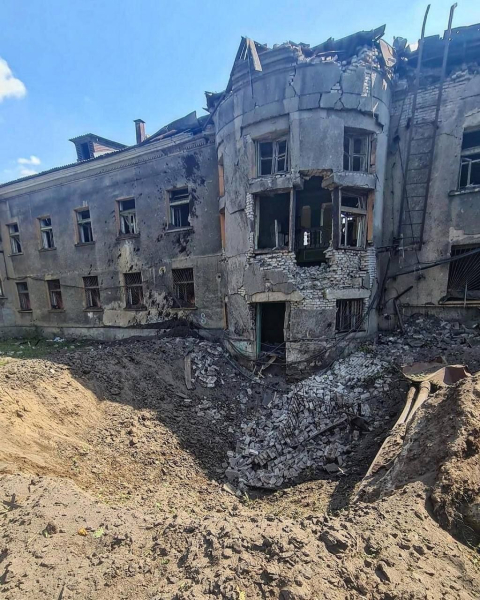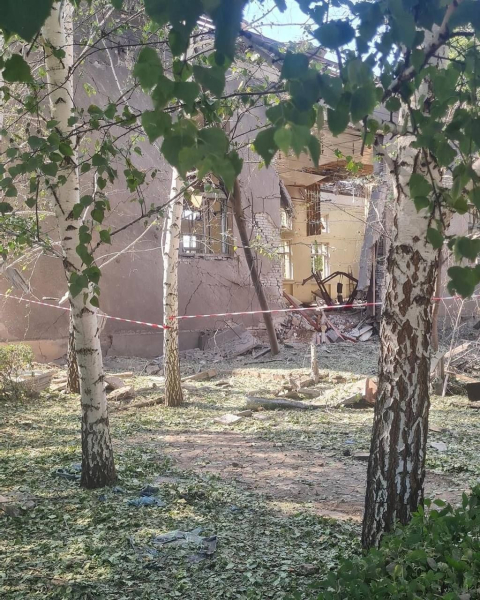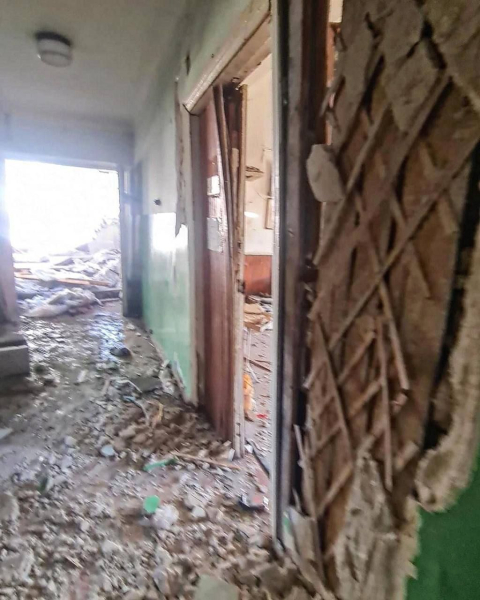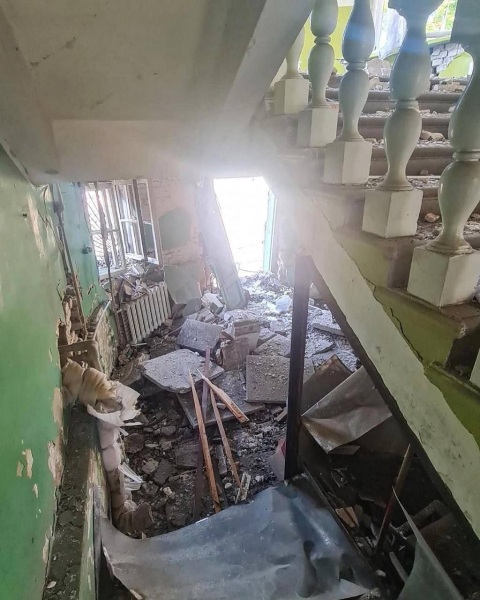In 2014, Druzhkovka saw what the “Russian world” was. After 8 years, the enemy returned with the same desire – to destroy and kill. Since February 2022, the city has been constantly living under Russian shelling. Now most of the residents of Druzhkovka have been evacuated, they will not return to the city soon.
Cossack borderland
In the Middle Ages, the lands of the northern Donbass were part of the Wild Field, from the 17th century an active process of colonization of the steppe began here: Cossack settlements appeared – farms and settlements, and the region itself received a new name Sloboda Ukraine or Sloboda Ukraine.
One of these settlers there was a semi-legendary Cossack Druzhko, who founded a beket, that is, an advanced guard on the banks of the Krivoy Torets River (now it is the territory of the village of Alekseevo-Druzhkovka, which is part of the Druzhkovskaya community).
By the way, Alekseev-Druzhkovka is the birthplace of the outstanding Ukrainian human rights activist Oleksa Tikhoy. Now the famous avenue, connecting 5 cities of Donbass, bears the name of Tikhoy and is the longest in Europe – more than 50 kilometers. :
 < /p>
< /p>




The details of the life of the Cossack Druzhko are unknown, except that he lived in the first half of the 17th century. However, his name in those parts was well-known much later.
In 1781, in the “Information about the land of the Yekaterinoslav governorship” Druzhkovka is mentioned as an ancient settlement of Ukrainian Cossacks, and it is especially noted that these are Cossacks, and not Sloboda Cossacks .
This is the first known written mention of the town. Now this date is considered the time of the founding of Druzhkovka and is even engraved on the monument to the Cossack Druzhko. The monument was erected in 2008 by grateful descendants, mixing sinful and righteous in a heap. Another monument to the legendary founder of the city will be erected in 2019 on Cathedral Square.


The history of the settlement on the northeastern slopes of the Donetsk Ridge near the confluence of the tributaries of the Krivoy Torts and Kazenny Torts is not limited to 1781 and is more ancient.
In the 17th and 18th centuries, these lands were frontiers and sometimes the scene of fierce battles.
Local local historians propose to consider the year 1711 as the time of the settlement's emergence – the time of the disastrous first Prut campaign for Peter, who, in order to save his life, had to give these lands to the Ottomans.
In 1768, a large Tatar army was defeated in the Druzhkovka region (it seems that it included not only Crimeans, but also Nogais, Polish confederates and French), and the next year the cavalry of the Kalgi Sultan Shahbaz-Gerai passed here – this was the last successful raid of the Crimean Tatars.
Ukrainian region
Muscovites repaid these victories in their own style. After the Russian occupation of Crimea, the threat from nomads for the empire disappeared, the Cossacks also became unnecessary, they were deprived of their own lands and made slaves (enslavement began in 1797 by decree of Emperor Paul the First), and the former Cossack foreman turned into old-world landowners.
< p> Then the Muscovites populate the former lands of the Cossacks with immigrants from the Kiev region, Kharkov region and Chernihiv region. Their new owners are the Shidlovskys, Arshenevskys, Annenkovs and others.
Censuses of the local population or “revisions” compiled at the end of the 18th century clearly show that Ukrainians lived in these parts:
- Ivanenko, Petrenko, Opanasenko, Artemenko, Grigorenko, Vasilenko, Ivanenko, Mikhailenko, Prokopenko, Petrusenko, Semenenko, Mironenko, Antoshchenko, Kondratenko, Tarasenko, Grishchenko, Kuzmenko and others that have arisen from proper names.
- A significant part surnames from the occupation of the owner of the surname – Goncharenko, Kramarenko, Shinkarenko, Kovalenko, Kravets, Kravchenko, Shevchenko, Miroshnichenko, Kushnirov, Kozhukhovsky, Tkach, Tkachenko, Bondarenko, Pisarenko, Pogrebnyakov, Kolisnichenko, Sklyarenko, Sklyar, Teslenko, Borinichenko and others.< /li>
- Surnames from the place of origin – Litvinenko, Kharkovsky, Tatarchenko.
The name of the “atamans” – the heads of the settlements – is also known. In Alekseevka it is Yakov Shpak, in Aleksandrovka it is Fyodor Spivachenko. After the introduction of serfdom, the name “ataman” will be replaced by the name “village headman”.
Railway
Capitalism gave a new impetus to the region. In the second half of the 19th century, an industrial revolution took place in the East of Ukraine, which radically changed the pastoral landscapes of the Sloboda region. The driving force behind progress was the Kursk-Kharkovo-Azov railway, in 1870 the Druzhkovka station appeared on the map.
Druzhkovka station”/Archival photo of the beginning of the 20th century
It got its name from the neighboring village – now Alekseevo-Druzhkovka, which was at a distance of 6 kilometers. In a few years, the first enterprise began to operate here – the sugar factory of Count Borisov. Gradually, the station grows and turns into a small working settlement, and later – into a powerful industrial center.
The French drew attention to the favorable location, logistics, easy access to raw materials and cheap labor and began to build their industrial hub in the vicinity of Druzhkovka. The French are building an iron and steel plant here, in 1894 the first blast furnace was blown out in Druzhkovka. The Toretsk (from the name of the river) metallurgical plant became one of the best in the Russian Empire and specialized in the production of railway rails.
Now the days of the industrial revolution in the Donbass are reminiscent of the houses of the late 19th – early 20th centuries, as well as the French cemetery in Druzhkovka, where workers and administrators of the metallurgical plant are buried. and a mechanical plant that also produced equipment for the railway.
Soviet occupation
The superprofits of foreign capitalists in Druzhkovka and the development of Donbass were interrupted by the First World War, and the revolution radically changed the rules of the game.
After the overthrow of tsarism, power in Druzhkovka changed many times (local historians give the number 22). The settlement, in which almost 15 thousand people lived, received the status of a city (later the Bolsheviks would deprive Druzhkovka of this status and return it only 20 years later – in 1938).
After the establishment of the Bolshevik occupation, the new government began to restore the industrial hub and increase its capacity. In 1929, the construction of a hardware (bolt) plant started in Druzhkovka; in October of the following year, it already began work. In 1936, the plant was named after the communist and Komsomol figure Alexander Kosarev, who is considered the founder of the Spartak society.
Kosarev was a loyal Stalinist, loved a bright life on a grand scale and mercilessly stigmatized all “enemies”, and therefore did not fall into the first waves of the repressed, having been their accuser, however, he did not escape execution – in 1939 he was executed, accused of some kind of crime against the “party”. The corpse of the Stalinist satrap was burned, and the remains were thrown into a common grave in one of the Moscow cemeteries.
A year before, the name of Kosarev disappeared from the name of the enterprise and it became the Druzhkovsky hardware plant. The company exists in our time, produces bolts, nuts and other parts important for bridge building and machine industry.
The hardware plant, together with the restored metallurgical enterprises, became the locomotive for the development of Druzhkovka. In 1938, the settlement received the status of a city of regional subordination. At that time, more than 30,000 people lived in Druzhkovka.
World War II brought great destruction to Druzhkovka. Already on October 22, 1941, the Soviet occupation was replaced by the German one. A significant part of the city's residents were evacuated along with industrial enterprises deep into the USSR, however, many residents were forced to stay.
More than 1,100 residents of Druzhkovka were killed by the Nazis, another 1,214 were sent to forced labor in Germany. The city was finally liberated from the Germans only on September 6, 1943.
The city was first liberated on February 6, 1943, during the so-called Operation Jump, which ended in disaster and heavy losses for the Red Army under the pressure of Manstein's tanks. After the war, Druzhkovka regained its status as an important industrial city in the Donetsk region. New enterprises were built here and old ones returned from evacuation.
The majority of the population of Druzhkovka are Ukrainians. The population census since the time of Independence (2001) showed that 75 thousand people live in the city, of which more than 64% are Ukrainians and 32% are Russians or Russified. At the beginning of the 20th century, many ethnic Russians moved to work at the Druzhkovka factories. Also, during the Soviet occupation, many residents of Russia arrived in Donbass to replace the Ukrainians killed during the Holodomor and repressions.
Unfortunately, the Druzhkovka station played a big role in the Stalinist genocide of Ukrainians – it was a transshipment base for the export of stolen peasants have grain and deportation of people.
The incident of the “Russian world”
The indisputable fact is that the years of Russification of Donbass have taken their toll. The 2001 census indicates that less than a third of the inhabitants of Druzhkovka considered Ukrainian as their native language. At the same time, 70% speak Russian.
Despite this, Druzhkovka did not want to become part of the “Russian world”. In 2014, Bezler's militants appeared in the city. City officials hid or took a wait-and-see attitude. At the same time, local residents organized themselves and created self-defense units – they did not allow the “separas” to become absolute masters of the city and forced them to reckon with themselves.
Thanks to this, it was possible to avoid large casualties and large-scale robberies, as well as save many hostages who were captured by the terrorists. Unfortunately, in a few months in the city, the militants did a lot of trouble, however, their scale could be much larger.
The self-defense of the city initiated secret negotiations, as a result of which the militants left Druzhkovka, when the offensive of the Armed Forces of Ukraine and volunteers began. On July 6, 2014, the city returned under the full control of Ukraine. Thus, he avoided destruction, and local residents – genocide and other social experiments of supporters of the “Russian world”.
Life in Druzhkovka after the occupation – watch the video:
An old house in the city center reminds of the crimes of Russian terrorists – in the courtyard near the Druzhkovsky City Council, a two-story building from 1892 was the office of the tsarist gendarmerie, the NKVD, the Gestapo.
In the 1980s, well-known Ukrainian dissidents Oleksa Tikhiy and Nikolai Rudenko were awaiting trial in these dungeons, and in 2014 the “DPR” terrorists set up their “commandant's office” here, but in fact – a torture chamber.
After the release of the city, local activists arranged in the house the Museum of Resistance of the Ukrainian Donbass to the occupation regimes “Druzhkivka Torture” to tell the truth about the crimes against Ukrainians.
Druzhkivka “bases”:


In 2022 in Druzhkovka again returned to the war. The city met her with the firm conviction that the occupier would never rule here again, and therefore let her follow the well-known course of the “Russian warship”.

